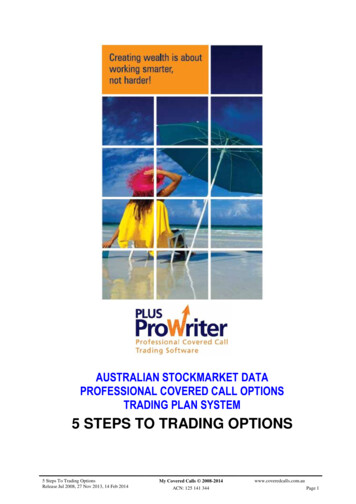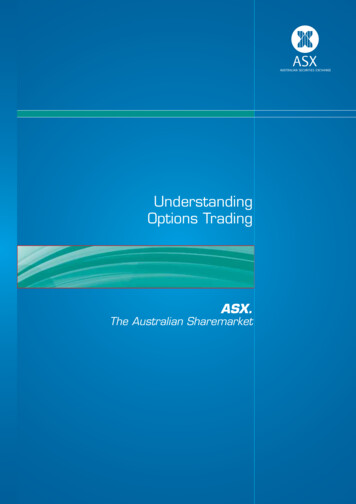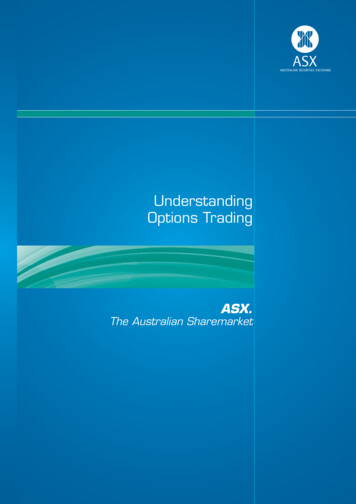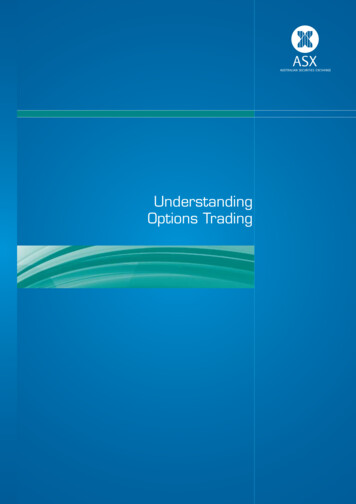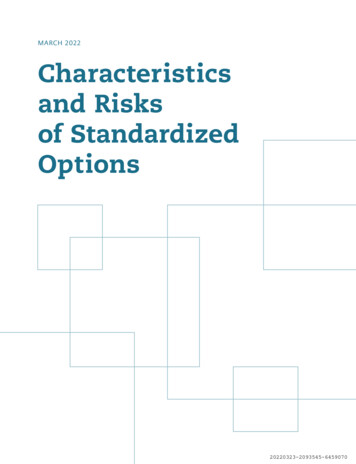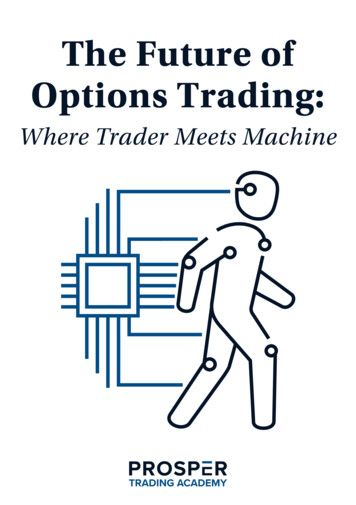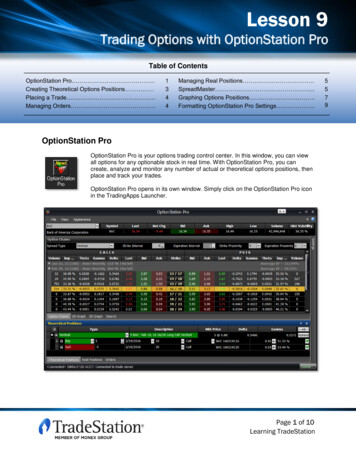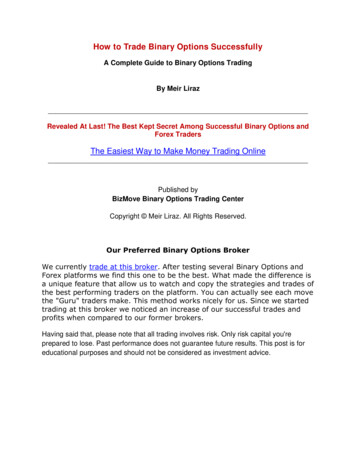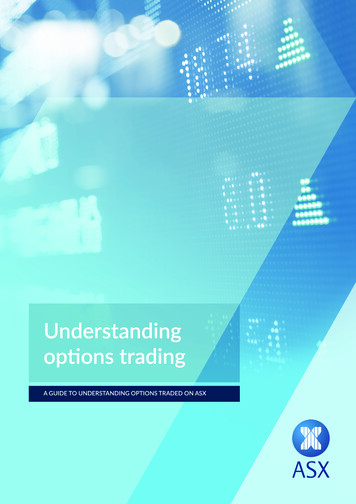
Transcription
1 Understanding options trading
DisclaimerInformation provided is for educational purposes and does not constitute financial productadvice. You should obtain independent advice from an Australian financial services licensee beforemaking any financial decisions. Although ASX Limited ABN 98 008 624 691 and its related bodiescorporate (“ASX”) has made every effort to ensure the accuracy of the information as at the dateof publication, ASX does not give any warranty or representation as to the accuracy, reliability orcompleteness of the information. To the extent permitted by law, ASX and its employees, officersand contractors shall not be liable for any loss or damage arising in any way (including by way ofnegligence) from or in connection with any information provided or omitted or from any one actingor refraining to act in reliance on this information.SPAN is a registered trademark of Chicago Mercantile Exchange Inc., used herein under license.Chicago Mercantile Exchange Inc. assumes no liability in connection with the use of SPAN by anyperson or entity.No part of this Booklet may be copied, reproduced, published, stored in a retrieval system ortransmitted in any form or by any means in whole or in part without the prior written permission ofthe ASX Group. Copyright 2016 ASX Limited ABN 98 008 624 691. All rights reserved 2016.
ContentsBefore you begin2What is an option?3Call options3Put options4Advantages of option trading5Risk management5Time to decide5Speculation5Leverage5Diversification5Income generation5Option features6The 5 components of an option contract61. Underlying securities/approved indices62. Contract size63. Expiry day64. Exercise (or strike) price75. Premium7Adjustments to option contracts8Option pricing fundamentals9Intrinsic value9Call options9Put options9Time value10The role of dividends in pricing and early exercise10Parties to an option contract11The option taker11The option writer131 Understanding options trading
Tracking positions and costs14How to track options positions14Co sts14Margins15Taxation16Tradeability17How can options work for you?18Trading index options20How are index options different?20Settlement method20Some key advantages of trading index options21Examples of how trading index options can work for you22Differences between equity options and index optionsPay-off diagrams2 Understanding options trading2324Call option taker24Call option writer24Put option taker25Put option writer25Summary26Risks of options trading27You and your broker28Your relationship with your broker28The paperwork: Client Agreement forms28Instructing a broker to trade options29Role of Market Makers30ASX Clear Pty LimitedOptions information on the ASX web site3233Glossary of terms35Option contract specifications37Further information38
Before you beginThe ASX options market has been operatingsince 1976. Since the market started, volumeshave increased significantly. There are nowover 60 different companies and the S&P ASX200 share price index to choose from. A list ofcompanies over which Exchange Traded Options(options) are traded can be found on the ASXwebsite, www.asx.com.au/options.This booklet explains the concepts of options,how they work and what they can be usedfor. It should be noted that this booklet dealsexclusively with Exchange Traded Options overlisted shares and indices, and not companyissued options. Information on other ASXproducts is available by calling 131 279 orvisiting www.asx.com.au. To assist in yourunderstanding there is a glossary of termson page 35.Option sellers are referred to as ‘writers’because they underwrite (or willingly accept)the obligation to deliver or accept the sharescovered by an option. Similarly, buyers arereferred to as the ‘takers’ of an option as theytake up the right to buy or sell a parcel of shares.Every option contract has both a taker (buyer)and a writer (seller). Options can provideprotection for a share portfolio, additionalincome or trading profits. Both the purchaseand sale of options, however, involve risk.Transactions should only be entered into byinvestors who understand the nature and extentof their rights, obligations and risks.3 Understanding options trading
What is an option?An option is a contract between two partiesgiving the taker (buyer) the right, but notthe obligation, to buy or sell a securityat a predetermined price on or before apredetermined date. To acquire this right thetaker pays a premium to the writer (seller) of thecontract.There are two types of options available:call options and put options.Call optionsCall options give the taker the right, but notthe obligation, to buy the underlying sharesat a predetermined price, on or before apredetermined date.For illustrative purposes, the term shares (orstock) is used throughout this booklet whenreferring to the underlying securities. Whenconsidering options over an index, the sameconcepts generally apply. From time to timeoptions may be available over other types ofsecurities.Call option exampleSantos Limited (STO) shares have a last saleprice of 8.00. An available 3 month optionwould be an STO 3 month 8.00 call. A takerof this contract has the right, but not theobligation, to buy 100 STO shares for 8.00 pershare at any time until the expiry*. For this right,the taker pays a premium (or purchase price)to the writer of the option. In order to take upthis right to buy the STO shares at the specifiedprice, the taker must exercise the option on orbefore expiry.The standard number of shares covered by oneoption contract on ASX is 100. However, thismay change due to adjustment events such asa new issue or a reorganisation of capital in theunderlying share.All of the examples in this booklet assume100 shares per contract and ignore brokerageand ASX fees. You will most definitely needto consider these when evaluating an optiontransaction. For options over an index, thecontract value is based on a dollar value perpoint. Details can be checked in the contractspecifications.TAKER(BUYER)BROKEROn the other hand, the writer of this call optionis obliged to deliver 100 STO shares at 8.00per share if the taker exercises the option. Foraccepting this obligation the writer receives andkeeps the option premium whether the option isexercised or not.ASXBROKERWRITER(SELLER)It is important to note that the taker is not obligated toexercise the option.* The expiry day for stock options is usually the Thursday before the last Friday in the expiry month unless ASX Cleardetermines another day. This may change for various reasons (eg. for public holidays), so please check with your broker.For index options, refer to the contract specifications. Please be aware this may change from 2016 with some stock optionsmigrating to expiry day being the third Thursday. Please check the ASX website or contact your broker.4 Understanding options trading
Put optionsPut options give the taker the right but notthe obligation to sell the underlying sharesat a predetermined price on or before apredetermined date. The taker of a put isonly required to deliver the underlying sharesif they exercise the option.Put option exampleAn available option would be an STO 3 month 8.00 put. This gives the taker the right, but notthe obligation, to sell 100 STO shares for 8.00per share at any time until expiry. For this right,the taker pays a premium (or purchase price) tothe writer of the put option. In order to take upthis right to sell the STO shares at a specifiedprice the taker must exercise the option on orbefore expiry. The writer of the put option isobliged to buy the STO shares for 8.00 pershare if the option is exercised. As with calloptions, the writer of a put option receives andkeeps the option premium whether the option isexercised or not.It is important to note thatthe taker is not obligated toexercise the option.If the call or put option is exercised, the sharesare traded at the specified price. This price iscalled the exercise or strike price. The last datewhen an option can be exercised is called expiryday.There are two different exercise styles:American style, which means the option canbe exercised at any time prior to the expiry; andEuropean style, which means the option canonly be exercised on the expiry day. Most stockoptions traded on ASX are American style.RIGHTS AND OBLIGATIONSCALL OPTIONTAKER(BUYER)Taker receives the right to buy shares at the exerciseprice in return for paying the premium to the writer.Writer receives and keeps premium butnow has the obligation to deliver sharesif the taker exercises.WRITER*(SELLER)PUT OPTION*TAKER(BUYER)Taker receives the right to sell shares at the exerciseprice in return for paying the premium to the writer.Writer receives and keeps premium butnow has the obligation to buy the underlying sharesif the taker exercises.WRITER(SELLER)5 Understanding options trading
Advantages ofoption tradingRisk managementPut options, when taken, allow you to hedgeagainst a possible fall in the value of shares youhold.Time to decideBy taking a call option, the purchase price forthe shares is locked in. This gives the call optionholder until the expiry day to decide whether ornot to exercise the option and buy the shares.Likewise the taker of a put option has time todecide whether or not to sellthe shares.SpeculationThe ease of trading in and out of an optionposition makes it possible to trade optionswith no intention of ever exercising them.If you expect the market to rise, you may decideto buy call options. If you expect a fall, you maydecide to buy put options.Either way you can sell the option prior toexpiry to take a profit or limit a loss.LeverageLeverage provides the potential to make ahigher return from a smaller initial outlay thaninvesting directly. However, leverage usuallyinvolves more risks than a direct investmentin the underlying shares. Trading in optionscan allow you to benefit from a change in theprice of the share without having to pay the fullprice of the share. The following example helpsillustrate how leverage can work for you.6 Understanding options tradingThe table below compares the purchase of 1 calloption and 100 shares. The higher percentagereturn from the option demonstrates howleverage can work.OPTIONSTOCKBought on October 15 38 400Sold on December 15 67 450Profit 29 50Return on investment(not annualised)76.3%12.5%DiversificationOptions can allow you to build a diversifiedportfolio for a lower initial outlay thanpurchasing shares directly.Income generationYou can earn extra income over and abovedividends by writing call options against yourshares, including shares bought using a marginlending facility. By writing an option you receivethe option premium up front. While you get tokeep the option premium, there is a possibilitythat you could be exercised against and have todeliver your shares at the exercise price.It is important that you balance the advantagesof trading options with the risks before makingany decisions. Details of the risks of optionstrading are set out on page 27.
Option featuresThe ease of trading in and out of optionson ASX‘s options market is assisted by thestandardisation of the following option contractcomponents:1. Underlying securities2. Contract size3. Expiry day4. Exercise pricesThere is a fifth component, the option premium,which is not standardised but rather determinedby market forces. ASX operates the optionsmarket, while ASX Clear Pty Limited (ASX Clear)operates the clearing facility for ASX‘s optionsmarket. Among ASX‘s responsibilities is thesetting of the standardised option components.1 option contract usuallyrepresents 100 underlyingshares.The 5 components of an optioncontract1. Underlying securities/approved indicesOptions traded on ASX‘s options market areonly available for certain securities and the S&PASX 200 share price index. These securitiesare referred to as underlying securities orunderlying shares. They must be listed on ASXand are selected by ASX Clear according tospecific guidelines. The issuers of underlyingsecurities do not participate in the selection ofsecurities against which options may be listed.Calls and puts over the same underlying securityare termed classes of options. For example,all call and put options listed over Lend LeaseCorporation (LLC) shares, regardless of exerciseprice and expiry day, form one class of option.A list of all the classes of options trading onASX‘s options market can be found on the ASXwebsite www.asx.com.au/options (in the‘Related information’ section on the ‘Volatilityparameters and ETO class rankings’ page).2. Contract sizeOn ASX‘s options market an option contractsize is standardised at 100 underlying shares.That means, 1 option contract represents 100underlying shares. As mentioned earlier, thismay change if there is an adjustment such as anew issue or a reorganisation of capital in theunderlying share. In the case of index options,contract value is fixed at a certain number ofdollars per index point (for example, 10 perindex point). The size of the contract is equal tothe index level x the dollar value per index point(for example, for an index at 4,500 points, 1contract would be 4,500 x 10 45,000).3. Expiry dayOptions have a limited life span and expire onstandard expiry days set by ASX Clear. Theexpiry day is the day on which all unexercisedoptions in a particular series expire and is thelast day of trading for that particular series.For options over shares this is usually theThursday before the last Friday in the month.*For index options, expiry is usually the thirdThursday of the contract month. ASX will alsolist weekly index options with the next two tothree weeks available, expiry day is Thursday.However, ASX Clear has the right to change thisdate should the need arise.As options expire new expiry months are addedfurther out.All option classes (stock or index) have expiriesbased on the financial quarters (March, June,September and December).* Please be aware this may change from 2016 with some stock options migrating to expiry day being the third Thursday.Please check the ASX website or contact your broker.7 Understanding options trading
For example, a June expiry means that theoption expires on the expiry day in June. IfThursday or Friday are not business days,the expiry day is brought forward to the nextbusiness day.A full list of all options series available fortrading is available on the ASX website,www.asx.com.au/options in the csv file‘Listed ETO code list’ in the ‘Related information’section. This list is updated daily.You can find a useful expiry calendar on the ASXwebsite: www.asx.com.au/options under “Expirycalendar” in the ‘Quick links’ section.For detail on option listing guidelines pleaseview the “Option listing guidelines.pdf” on theASX website: www.asx.com.au/options in the“Quick links” section.4. Exercise (or strike) pricesThe exercise price is the predetermined buyingor selling price for the underlying shares if theoption is exercised.ASX Clear sets the exercise prices for all optionslisted on ASX‘s options market with a range ofexercise prices available for options on the sameexpiry. New exercise prices are listedas the underlying share price moves.For example, if the underlying share is trading at 3.50, it is likely that option contractswith the following strike prices would be listed: 3.00, 3.25, 3.50, 3.75 and 4.00.A range of exercise prices allows you to moreeffectively match your expectations of the pricemovement in the underlying share to your optionposition. Exercise prices may also be adjustedduring the life of the option if thereis a new issue or a reorganisation of capitalin the underlying shares.8 Understanding options trading5. PremiumThe premium is the price of the option whichis arrived at by the negotiation between thetaker and the writer of the option. It is the onlycomponent of the five option components that isnot set by ASX Clear.Option premiums are quoted on a cents pershare basis. To calculate the full premiumpayable for a standard size option contract,multiply the quoted premium by the numberof shares per contract, usually 100.For example, a quoted premium of 16 centsrepresents a total premium cost of 16.00( 0.16 x 100) per contract. To calculate the fullpremium payable for an index option, you simplymultiply the premium by the index multiplier. Forexample, a premium of 30 points, with an indexmultiplier of 10, represents a total premiumcost of 300per contract.No eligibility for dividends and votingThe taker of the call option or the writer ofa put option does not receive dividends onthe underlying shares until the shares aretransferred after exercise. Nor do they obtainany voting rights in relation to the shares untilthat time.Option information isavailable on our websitewww.asx.com.au
Adjustments tooption contractsThe specifications of option contracts listed onASX‘s options market are standardised as muchas possible.However, ASX may make adjustments to optionsto preserve, as far as practicable, the value ofpositions in options held by takers and writers.Adjustments are made as a result of corporateevents that affect the price of the underlying,such as a bonus issue, share split or rights issue.Adjustments may be made to one or more ofthe components of an option, including exerciseprice, contract size, underlying securities, andnumber of contracts. With some events, ASX hasadopted adjustments which are understood bythe market to be conventions that will generallybe applied when those circumstances arise.Specific adjustments are set out in the ASXOperating Rules.The adjustment assumes that the corporateevent giving rise to a need to make anadjustment has an ex-date or a deemed exdate, and the event must affect the parcelof underlying securities. ASX considers thatthe value of the option to both the taker andthe writer is best preserved over the ex-dateby maintaining the total exercise value. Thetotal exercise value is the product of threeparameters:Corporate events that do not strictlyaffect shares in a pro-rata manner, that isproportionally, are generally excluded from anoption adjustment. For instance, an entitlementissue of 50 shares for each shareholder,(irrespective of the number of shares held bya shareholder) is not a strictly pro-rata issue.But a bonus issue of 1 for 2 does result in anadjustment as it is a pro-rata issue of 50 newshares for each 100 old shares held.The various adjustment circumstances and also adetailed treatment of option adjustments, titledExplanatory Guide for Option Adjustments canbe found on the ASX website atwww.asx.com.au/options (in the quick linkssection under corporate actions).This document covers: what an adjustment is why adjustments are made how adjustments are determined different types of adjustments examples of past adjustments. the quantity of option contracts the number of the underlying securitiesrepresented by the option contract the exercise price of option contracts inthe series.9 Understanding options trading
Option pricingfundamentalsWhen considering an option it is importantto understand how the premium is calculated.Option premiums change according to a rangeof factors including the price of the underlyingshare and the time left to expiry. An optionpremium can be separated into two parts –intrinsic value and time value. Different factorsinfluence intrinsic and time value.Time valueThe amount you are willing to pay for thepossibility that you could make a profit fromthe option transaction. It is influenced bythe following factors: time to expiry volatility interest ratesIntrinsic valueIntrinsic value is the difference between theexercise price of the option and the market priceof the underlying shares at any given time. Hereare some examples for call and put options.Time valueTime value represents the amount you areprepared to pay for the possibility that themarket might move in your favour during thelife of the option. Time value will vary within-the-money, at-the-money and out-of-themoney options and is greatest for at-the-moneyoptions.As time draws closer to expiry and theopportunities for the option to becomeprofitable decline, the time value declines. Thiserosion of option value is called time decay. Timevalue does not decay at a constant rate, butbecomes more rapid towards expiry. dividend payments market expectations.Call optionsFor example, if BHP Limited (BHP) June 30.00call options are trading at a premium of 1.50and BHP shares are trading at 31.00 per share,the option has 1.00 intrinsic value. This isbecause the option taker has the right to buy theshares for 30.00 which is 1.00 lower than themarket price. Options that have intrinsic valueare said to be ‘in-the-money’.BHPSHAREPRICE 31.00OPTIONPREMIUM 1.50 INTRINSICVALUE(Share price- ExcercisePrice) 1.00 TIME VALUE(Option Premium- Intrinsic Value) 0.50CALL OPTION EXERCISE PRICE 30.00In this example, the remaining 50 cents of thepremium is time value.TimevalueTimeExpiry DayHowever, if the shares were trading at 29.00there would be no intrinsic value because the 30.00 call option contract would only enablethe taker to buy the shares for 30.00 per sharewhich is 1.00 higher than the market price.When the share price is less than the exerciseprice of the call option, the option is said to be‘out-of-the-money’.Remember, call options convey to the takerthe right but not the obligation to buy theunderlying shares. If the share price is belowthe exercise price it is better to buy theshares on the sharemarket and letthe option lapse.10 Understanding options trading
Put optionsPut options work the opposite way to calls.If the exercise price is greater than the marketprice of the share the put option is in-the-moneyand has intrinsic value. Exercising the in-themoney put option allows the taker to sell theshares for a higher price than the current marketprice.For example, a BHP July 31.00 put optionallows the holder to sell BHP shares for 31.00when the current market price for BHP is 30.00. The option has a premiumof 1.20 which is made up of 1.00 of intrinsicvalue and 20 cents time value.A put option is out-of-the-money when the shareprice is above the exercise price, as a taker willnot exercise the put to sell the shares below thecurrent share price.BHPSHAREPRICE 30.00OPTIONPREMIUM 1.20 INTRINSICVALUE(Share price- ExcercisePrice) 1.00 TIME VALUE(Option Premium- Intrinsic Value) 0.20PUT OPTION EXERCISE PRICE: 31.00Once again, remember put options conveythe right but not the obligation to sell theunderlying shares. If the share price isabove the exercise price it is better to sellthe shares on the share market and let theoption lapse.When the share price equalsthe exercise price, the calland the put options are saidto be ‘at-the-money’.The role of dividends in pricingand early exerciseWhen a share goes “ex-dividend” its price usuallyfalls by the amount of the dividend. As optioncontracts do not carry any right to dividendspaid on the underlying shares it follows thatoption prices, both puts and calls need to takeaccount of any dividend likely to be paid duringthe life of the option. Although companiesusually follow a pattern as to the timing and theamount, these can change.Options investors need to make an assessmentof when and how much a dividend is likely to beand factor this into their assessment of the fairvalue of any particular option series. The ASXtheoretical options price calculator can assistwith this task.Dividend payments can also influence thelikelihood of an option being exercised early.ASX also has a calculator to assist with assessingthis likelihood.The key factors which affect the time value ofan option are: Time to expiry – The longer the time to expiry,the greater the time value of the option. Volatility – In general, the more volatile theprice of the underlying share or index, thehigher the premium will be. This is due tothe wider range over which the stock canpotentially move. Interest rates – A rise in interest rates willpush call option premiums up and put optionpremiums down. Dividend payments – If a dividend is payableduring the life of an option, the premium of acall option will be lower, and the premium ofa put option higher, than if no dividend waspayable. Holders of option contracts who donot own the underlying securities are noteligible for dividends payable on those shares. Market expectations – Ultimately supplyand demand determine the market value ofall options. During times of strong demand,premiums will be higher.11 Understanding options trading
Parties to an optioncontractThe option takerAn option taker is an investor or traderanticipating a significant move in a particularshare price. Taking an option offers theopportunity to earn a leveraged profit witha known and limited risk.Taking a call option gives you the right to buythe shares covered by the option at the exerciseprice at any time until expiry. In general, calloption premiums rise as the underlying shareprice rises. For this reason the taker of a calloption expects the underlying share price willrise.Taking a put option gives you the right, butnot the obligation, to sell the underlying shares.Put option premiums usually rise as theunderlying share price falls. For this reason thetaker of a put option expects the underlyingshare price to fall.In taking this right to buy or sell shares,the taker pays the premium. This premiumrepresents the maximum possible loss onthe option for the taker.It is important to remember that it is notnecessary for the taker of a put option to ownthe underlying shares at the time of taking theput. Certainly, if the taker chooses to exercisethe put option they will be required to deliverthe underlying shares, at the exercise price, to arandomly selected writer of put options in thatseries. However, the taker also has the choice ofclosing out the position on ASX‘s options marketprior to expiry. A full explanation of closing outcan be found on page 17.If the taker chooses to close out the option, aloss will be incurred if the premium that theinvestor receives on closing out is lower than thepremium paid by the investor for the originaltaken contract. A profit will occur if the reverseis true. Any time value in the premium for theoption will be lost if the option is exercised.12 Understanding options tradingOn average 15% of options are exercised.However this does not mean 85% expire orworthless. Instead 60% of options are closedout whilst 25% expire worthless. These figuresrepresent the average over recent times andmay vary depending on current volatility andother features.Assume AMP Limited (AMP) shares are tradingat 5.75. Anticipating an increase in the shareprice, you take a 3 month AMP 5.75 call for 45cents, or 45 total premium ( 0.45 x 100 sharesper contract).Close to the expiry day, AMP shares are tradingat 6.75 and the option premium is now 1.02per share. You could exercise the option and buy100 AMP shares at 5.75, which is 1.00 belowthe current market price, realising a gain of 55cents per share: 1.00 – 0.45 0.55 (excludingbrokerage and exchange fees).Alternatively you can close out the call onASX‘s option market by completing an equaland opposite transaction to your openingtransaction. In this example you would writean AMP August 5.75 call for 1.02 (the currentpremium) and realise a gain of 57 cents per share(excluding brokerage and exchange fees).The 2 cent profit difference between exercisingand closing out the call is due to the optionhaving some remaining time value (as explainedon page 10).If AMP shares had declined over this period,the call premium would have also declined.Depending on the timing and magnitude ofthe share price decline, the option may haveretained some value prior to expiry, allowingyou to recoup a portion of the original premiumby liquidating the position. The first table on thefollowing page summarises the two alternatives.
EXERCISE vs CLOSEOUTEXERCISE vs CLOSEOUTCURRENT HOLDING: ONE 5.75 AMP CALLAMP SHARES TRADING AT 6.75CURRENT HOLDING: ONE 6.25 AMP PUTAMP SHARES TRADING AT 5.00EXERCISECLOSEOUTExercise option / buy 100AMP shares for 5.75*Closeout / sell ONE AMP 5.75 call for 1.02**Sell 100 AMP sharesat market price of 6.75*Total profit 6.75 - 5.75 1.00 pershare ( 100)Less initial cost 1.02 - 0.45 0.57cents profit per share( 57)Less initial cost 1.00 - 0.45 0.55cents profit per share( 55)* Fees and Commission are payable on each of these steps** Fees and Commission are paid on the sale of the optionto closePut buying exampleEXERCISECLOSEOUTBefore exercising option,buy AMP shares atmarket price of 5.00*Close out / sell ONE AMP 6.25 put for 1.30**Exercise put and sell 100AMP shares for 5.25*Total profit 6.25- 5.00 1.25 per share ( 125)Less initial cost 1.30 - 0.15 1.15profit per share ( 115)Total profit 6.75 - 5.75 1.00 pershare ( 100)Less initial cost 1.02 - 0.45 0.57cents profit per share( 57)Less initial cost 1.25 - 0.15 1.10profit per share ( 110)* Fees and commission are payable on each of these steps** Fees and commission are paid on the sale of the optionto closeSay AMP Limited (AMP) shares are trading at 6.48. Anticipating a fall in the share price, youtake a 3 month AMP 6.25 put option for 15cents per share.Close to the expiry day, AMP shares are tradingat 5.00 and the option premium is now 1.30per share.You could exercise the option and sell 100 AMPshares at 6.25 which is 1.25 above the currentmarket price, realising a gain of 1.10 per share(excluding brokerage and exchange fees). Ifyou don’t own the shares you would need topurchase these before exercising the put option.Alternatively, you could close out the option byselling the 3 month AMP 6.25 put at 1.30 (thecurrent market premium) and realise a gain of 1.15 per share (excluding brokerage and exchangefees). The 5
4 Understanding options trading * The expiry day for stock options is usually the Thursday before the last Friday in the expiry month unless ASX Clear determines another day. This may change for various reasons (eg. for public holidays), so please check with your broker. For index options, refer to the contract specifications.
